
Caption: Asteroid Vesta in a direct image (from the HST, 1997), a model, and a topographic map.
Vesta (formally 4 Vesta), the 3rd largest asteroid, has average diameter 525.4 km. But despite its large size, it isn't all that spherical as one can see. Self-gravity has NOT won a complete victory in spherizing Vesta
A large impact crater with a crater central peak near the south is clear on the topographic map. The impact crater has a diameter of about 400 km.
Vesta has basaltic rock, and so is thought to have undergone volcanism and chemical differentiation in the early Solar System.
Perhaps many asteroids larger than 100 km underwent some chemical differentiation and volcanism in the early Solar System.
But their residual heat of formation and past radioactive heat were lost quickly and they became inactive for internal-heat geology early on.
Vesta and smaller asteroids might have owed their heat energy and chemical differentiation and internal heat due to aluminum-26 (half-life 0.717 Myr) and perhaps other relatively short-lived radioactive isotopes (see Wikipedia: Aluminium-26: Occurrence in the interstellar medium; ).
The short-lived radioactive isotopes would have to have been produced by a supernova that went off shortly before Solar System formation and that seeded the primordial nebula with its debris enriched in metallicity and radioactive isotopes.
See reference see Se-565.
Credit/Permission: NASA,
1997 /
Public domain.
Image link: itself.
Download site: Views of the Solar System by Calvin J. Hamilton.
File: Asteroid file:
004_vesta_hst.html.